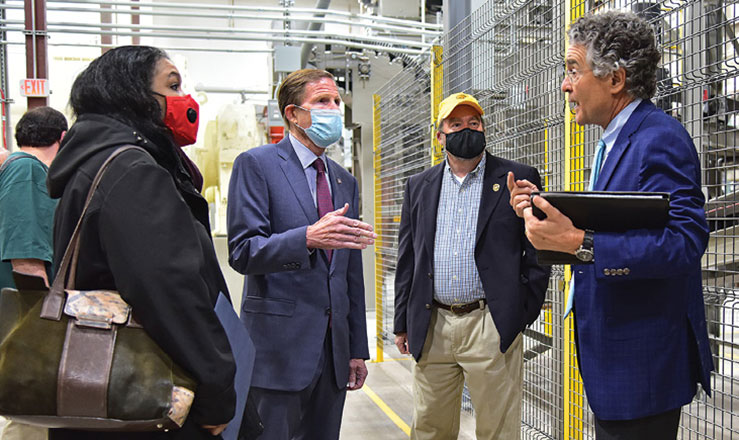From bottles to buildings: Recycled glass gets new life in cement product
In most of the U.S., the effort to recycle glass continues to be an economic and logistical challenge that most municipalities have not quite found a solution for yet. Much of it continues to go to landfills.
For Urban Mining CT, this large-scale waste was seen as an opportunity.
The Grasso family, for several years, owned a concrete block manufacturing plant in Kingston, New York, so they were familiar with the downsides of building with concrete. For one thing, it creates significant environmental emissions.
“In the concrete and cement industry, cement is a critical component to building that we do globally,” said Patrick Grasso, managing partner at Urban Mining CT. “The production of cement is a big producer of carbon dioxide ”” almost on a ton-for-ton basis.”

The concrete industry has traditionally utilized materials called pozzolans in the past to replace cement. One of the most popular, however, was fly ash, a by-product of burning coal for power ”” which is becoming, of course, less and less available.
“There had been growing shortages in these historic products, such as fly ash and slag,” Grasso said. “Fly ash is from our coal burning power plants, and we”™re shutting them all down, and slag is primarily an imported product, because it”™s a by-product of making steel, and we don”™t make much of that domestically either. So those products either became in short supply or more expensive, and were industrial-based products.”
So Patrick”™s nephew, Louis Grasso, managing partner of Urban Mining CT, invented a product that addressed this problem, along with the difficulties of recycling glass material, and created Pozzotive, a new kind of pozzolan cement replacement made entirely from postconsumer recycled glass.
Not only does it stop the glass from heading to landfills and replace emission-heavy cement, it makes the product perform better, making it stronger and more durable, and more resistant to breakdown from road salt chloride penetration, sulfate attack and moisture penetration.
The price is on par with normal concrete.
Unlike other glass recycling methods that require batches of glass with a uniform melting point in order to repurpose, the process for Pozzotive can use virtually any type of glass ”” which it obtains from regional material recovery facilities ”” even those that cause problems for other manufacturers.
“We can take the occasional ceramics and porcelains that are mixed in there that otherwise cause problems for bottlers and fiberglass companies, because they have a different melting temperature,” Patrick said. “So it allows us to take more of a mixed bag of recycled products that cause other people headaches.
It can be manufactured in any market where glass is available, offering municipalities a consistent destination for postconsumer glass of any variety, size or color. Keeping things local is another aspect that lowers the carbon footprint of the material; by taking local glass and recycling to create building materials for local markets, material transportation costs and emissions are cut down.
For Urban Mining CT’s new manufacturing plant, the rationale for the Connecticut location was twofold: it was in a state struggling with a solution for glass recycling, and it was proximal to the New York metro area construction market.
The company announced the grand opening of the plant on May 10. It will employ about a dozen people, estimated to increase over time, and will supply Pozzotive products to the area.
“We”™re permitted for 100,000 tons per year, and we”™re probably estimating in the early years more in the range of probably 50,000-plus tons, to go up over time,” Patrick said.
Several local officials attended the grand opening, including U.S. Sen. Richard Blumenthal from Connecticut.
“Connecticut”™s greatest asset is its people ”” inventors and innovators who bring new products to market that benefit us for lifetimes,” Blumenthal said. “This plant is Exhibit A, recycling glass waste to produce a material used to make high-quality, climate-friendly concrete. More than a win-win, it is a kind of virtuous circle.”
Pozzotive has already been incorporated into a number of notable projects. In New York City, it has been used to construct 2nd Avenue Subway stations, the Halletts Point high-rise building, four buildings in Hudson Yards and several sidewalk pours, among other projects. It was also used in the United Nations Plaza; the Pozzotive in the pavers for that project was actually created from old window glass from the UN General Assembly Building.
In Connecticut, it’s been used in Stamford’s Metro Green, the ESPN Digital Center 2 in Bristol and the University of Connecticut Wastewater Treatment Plant in Storrs.
It has received awards from the US Environmental Protection Agency, Building Green and, most recently, by the Northeast Recycling Coalition.
There are also more products it can be incorporated into, including industrial filler and abrasive blasting media, which Urban Mining CT also produces.
So far, it has been used in 10 million concrete masonry units, 750,000 square feet of pavers and 500,000 square feet of prestressed concrete planks and blocks.
There is certainly no lack of supply, as only about a third of postconsumer glass in the U.S. is successfully recycled each year.
“It”™s a perfect circular story in a community to be telling,” Patrick said. “For example, we”™re doing a school up in (Darien), where it”™s glass coming from the area that is being repurposed and Pozzotive is being created and going back into a new school in Connecticut. So it”™s a great story to tell if you can take your local glass, harvest it locally, process it, manufacture it and use it locally ”” and in doing so you can reduce the carbon footprint in your community ”” then what a great story, on all fronts. So we continue to want to tell it and we”™re excited about it.”